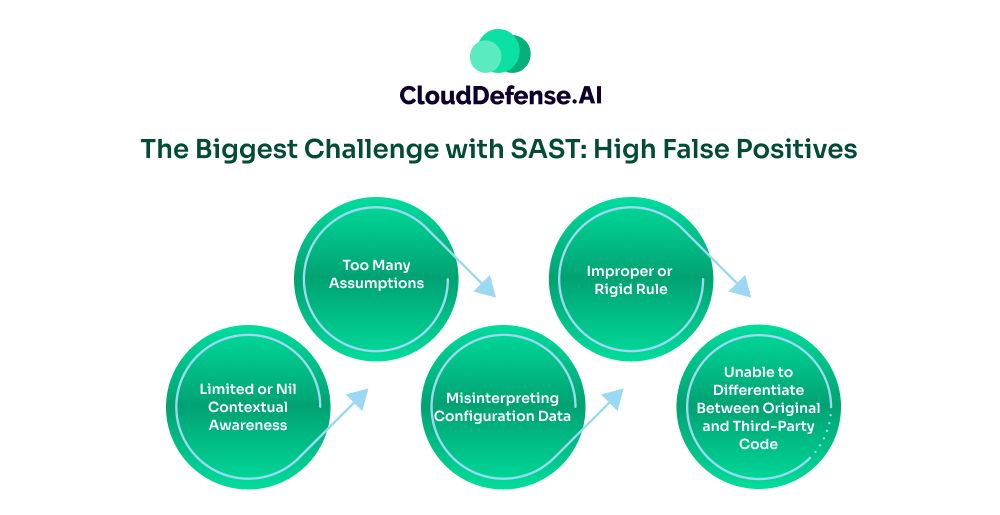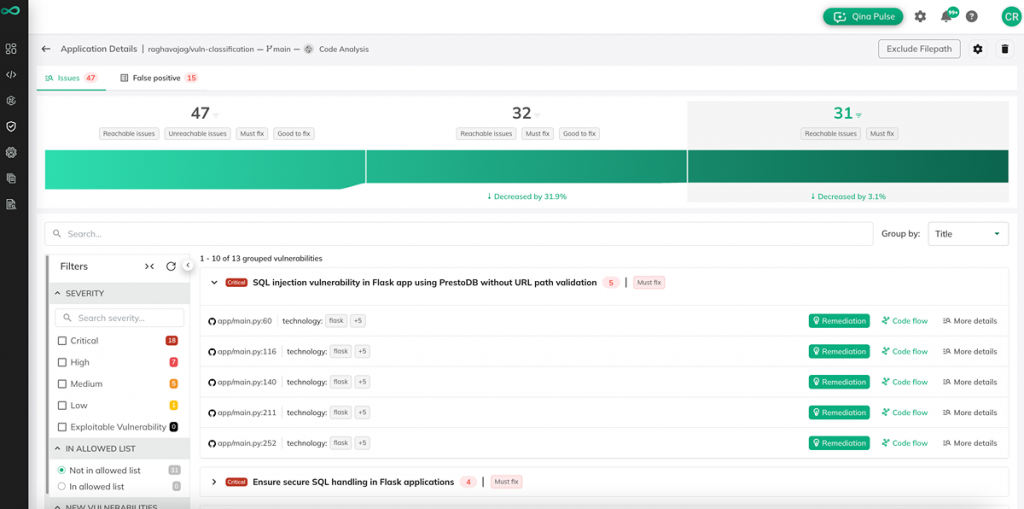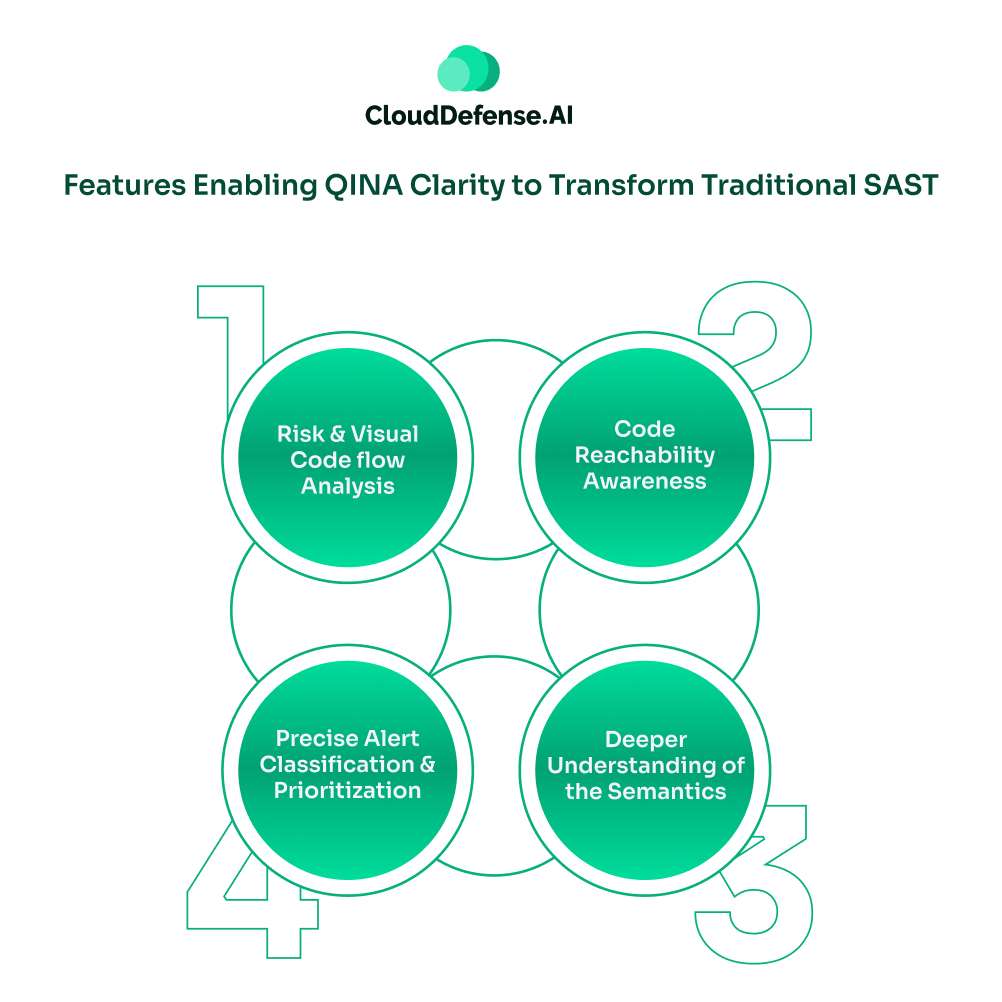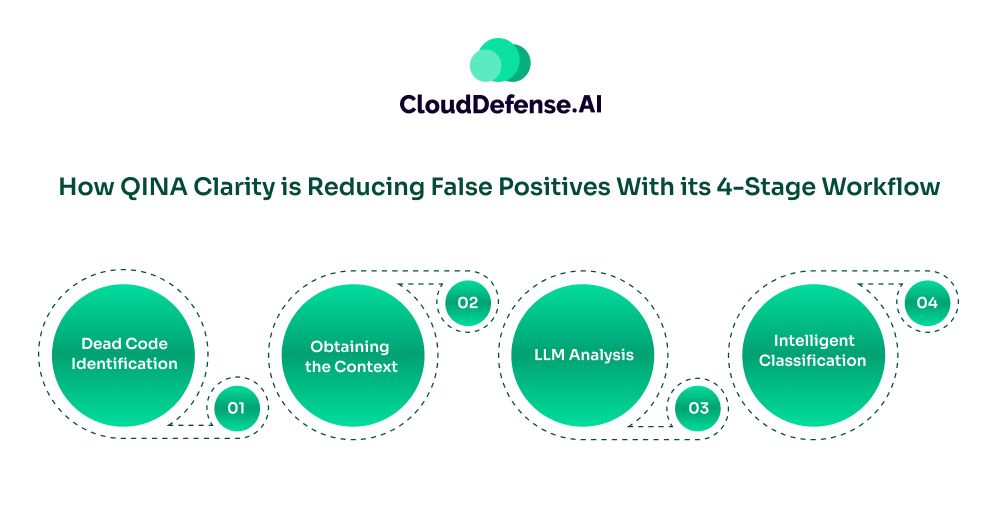The number of data breaches is increasing daily. In 2024, the number of data breach alerts reached 1.7 billion approximately only in the US. Static Application Security Testing (SAST) has been a crucial tool in helping organizations secure application development processes. It enables developers to identify vulnerabilities in the beginning before they are committed.
Despite being beneficial, traditional SAST has marred the application development process with a huge number of false positives. Around 60% of security alerts provided by SAST are false positives. Now, the question arises: how do you solve such issues and prevent your development workflow from slowing down? In comes QINA Clarity which is a next-generation AI SAST. It not only eliminates noise in scans of codes but also reduces false positives in SAST. Today, we take a detailed look at how to reduce false positives in SAST with QINA Clarity.
The Biggest Challenge with SAST: High False Positives

SAST works by analyzing the codebase in the CI/CD pipeline and identifies vulnerabilities before they reach the production stage. However it operates on a strict rule-based system, and predefined patterns to discover vulnerabilities in the source code. While traditional SAST safeguards code in SDLC, it overwhelms developers.
As it incorrectly flags codes, it leads to a slowed development cycle, SAST alert fatigue, wastage of crucial time, and ignorance of real threats. It is estimated a significant amount of time (almost 40%) in the developer’s security analysis workflow is spent on assessing false positives.
Besides the predefined rules, what makes SAST generate so many high false positives? Here are some of the major causes behind high false positives:
- Limited or Nil Contextual Awareness: SAST analyzes static codebases based on predefined rules and patterns that often lack context. The rules are rigid and often non-flexible so they don’t adapt with the project’s intent, business logic, and coding standards of the organization. As a result, it is not able to understand the developer’s intent and flag codes that are not vulnerable.
- Too Many Assumptions: Certain SAST tools are customized with a large number of assumptions to work flexibly with different types of codebases. These assumptions or patterns are mostly predefined and generic. When this tool triages a code based on such an assumption, it often finds some source code unusual. This leads to high false positives.
- Misinterpreting Configuration Data: In many situations, the dependency of a codebase may lack information on up-to-date security patches. Since the pre-defined rule or vulnerability database is not updated with the information of the latest patch, it leads to false positives.
- Improper or Rigid Rule: As we have already discussed, one of the major reasons behind huge false positives is improperly designed or rigid rules. Traditional SAST is mostly designed on strict and non-adaptive rules. Moreover, they are not flexible enough to understand certain frameworks. Because of this, it often flags codes even if it finds the slightest hint and ensures they are assessed by developers.
- Unable to Differentiate Between Original and Third-Party Code: SAST tools often find it difficult to differentiate between original and third-party codes. As a result, the AppSec tool often flags codes and leads to false positives in third-party libraries.
QINA Clarity: Efficiently Reducing False Positive

SAST alert fatigue is a major issue with common SAST tools. But QINA Clarity has emerged as the proficient AI SAST tool that empowers development teams to intelligently identify vulnerabilities and minimize false positives. This AI-powered SAST tool eliminates noise in the scans of codes and provides meaningful alerts to the developers.
Unlike traditional SAST, it not only scans the codebase but also understands the context and makes analysis based on it. It leverages AI and ML to enhance the vulnerability identification process and deliver better accuracy in raising alerts. Thus, it is able to reduce the false positive by a significant margin and provide a reliable security outcome.
With QINA Clarity, developers eliminate the inefficiencies that come with an overwhelming number of false positives and help developers utilize their time efficiently. It seamlessly integrates with the CI/CD pipelines and IDE to automate the scanning of the code in the development workflow.
This modern AI SAST supports most of the programming languages and different frameworks. Plus, it is always learning from new code, public libraries, vulnerability lists, and human feedback. This helps the tool get a wide visibility into evolving vulnerabilities and improve accuracy.
Features Enabling QINA Clarity to Transform Traditional SAST

QINA Clarity is an intelligent SAST tool that combines AI, ML, and various data analysis techniques to smartly understand a code beyond its standard context. Here are some key features that transform how traditional SAST understands code:
- Risk and Visual Code flow Analysis: QINA Clarity are trained on different repositories containing billions of line codes. Plus it is constantly learning from current codebases and libraries. Thus is able to provide a complete analysis of the exploitability of a code and how it can impact the business. It also showcases a complete code flow from input to vulnerable execution point. It doesn’t involve complex security details, enabling developers to understand the impact of the vulnerability.
- Code Reachability Awareness: One of the defining features of QINA Clarity is its capability to understand code reachability. It can clearly differentiate between reachable and unreachable code paths. Reachable codes are those whose paths can be executed whereas unreachable codes lack executable paths.
- Precise Alert Classification and Prioritization: This advanced AI SAST is built with advanced pattern recognition. Plus, it is trained on a vast database of vulnerable and secured code. So this AppSec tool can easily identify and assess the severity of the vulnerability. It assesses the code through a 4-stage pipeline and precisely prioritizes the alert. It also considers factors like impact vulnerability, exploitation possibility, and penetration of the code. Importantly, it provides vulnerability context and tags associated with the code for better understanding. It provides OWASP and SANS references on the tags for a complete context. Thus, it helps the developers to prioritize the issue with the highest severity.
- Deeper Understanding of the Semantics: This AI-backed SAST can comprehend a code by using the NLP technique and understand the semantics behind a specific code. It is highly useful in understanding the motive behind a function and variable name. It can tally the semantic information to code behavior and understanding in a better way about the security impact of the code. This eliminates the chances of false positives and guides developers to real threats.
How QINA Clarity is Reducing False Positives With its 4-Stage Workflow

QINA Clarity leverages a 4-stage intelligent analysis process that converts all the noise in the code scan into usable security insight. It puts all the scans through a 4-stage detailed analysis to reduce false positives. Here is a detailed overview of the 4-Stage workflow:
- Stage 1: Dead Code Identification: QINA Clarity gathers all the available raw security findings. Then it performs static analysis to highlight code paths that are unreachable. It considers factors like conditional blocks that weren’t executed, unutilized functions, post-return statements, and exception handlers. It also debugs specific ones that weren’t needed in production. Based on analysis, it classifies the reachability of each finding.
- Stage 2: Obtaining the Context: Now, this AI SAST tool takes into account the reachable vulnerabilities that it has classified along with the associated code. In this stage, it opts for gathering context from call patterns of functions, variable typing and scope information, and framework security patterns. A data and control flow assessment from input to reachable vulnerability is performed alongside. As a result, a lot of contextual data is extracted that will be utilized for LLM analysis.
- Stage 3: LLM Analysis: It is a crucial stage where LLM analysis is done by involving the business logic. It takes code, complete context, and known vulnerability patterns as input. During the LLM analysis, the process explores the business impact, attack vectors, exploitable path, and remediation strategies that can be utilized. In the end, it provides a detailed report on the vulnerability analysis along with remediation details.
- Stage 4: Intelligent Classification: In this last stage, this tool performs a final intelligent classification by taking LLM output and reachability data as input. It categorizes the findings into three categories: must fix, good to fix, and false positive. The must-fix category involves severe, high-impact, and exploitable findings. The good-to-fix category highlights findings that have low to medium security risk but have security concerns. The false positive category indicates the dead codes or findings that are non-exploitable. This leads to actionable, categorized, and prioritized security findings that can greatly benefit developers. Based on the categorization, the developers can approach the alert without facing SAST alert fatigue.
Overall Result
With the integration of QINA Clarity in the application development workflow, developers can expect a significant reduction in false positive alerts and investigation time. This AI-powered solution performs a thorough code security analysis of every code. In a recent test, QINA Clarity tested an application repository.
The AI SAST tool came up with an effective result where it found a total of 565 vulnerabilities. Among all the findings, there were 335 actual vulnerabilities while the rest 230 were false positives. As a result, QINA Clarity was able to benefit the developer by:
- Reducing the security alert investigation by 41%.
- Helping to focus on the high priority and actual vulnerabilities that were 335.
- Accurately classified which findings are critical and which are the false positives.
- Detailed report of the vulnerabilities with visual evidence.
- Real-time remediation suggestions and steps to follow.
- Maintained a quicker application development cycle without compromising on the security posture.
Final Thought
Organizations relying on the SAST tool for scanning code security are frustrated with high SAST alert fatigue. Traditional SAST lacks the capability to understand the context and prioritize vulnerability. If you are also facing the same issue, QINA Clarity can be your answer. It helps reduce the investigation time by accurately identifying and classifying vulnerabilities.
It utilizes a 4-stage pipeline for all the security findings from code static analysis and provides a detailed report. This helps developers to focus on the real threat rather than navigating through all the alerts. Besides, it performs detailed analysis and provides useful remediation details for all the actual findings. So without any delay, get your hands on QINA Clarity and integrate with your CI/CD pipeline.







